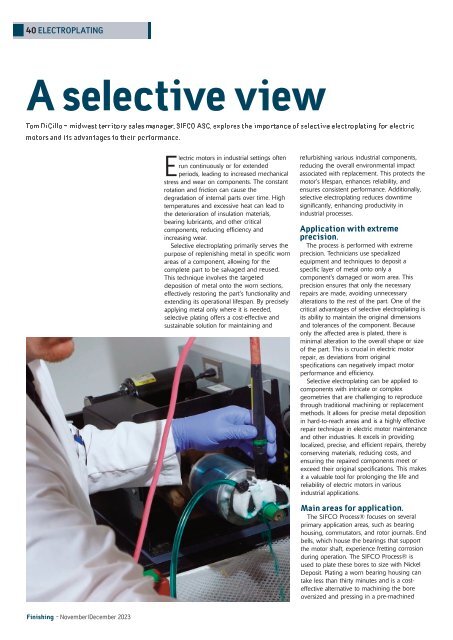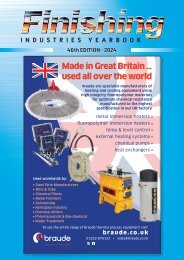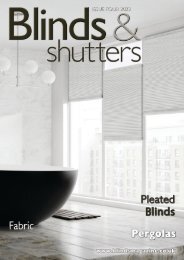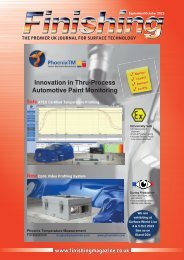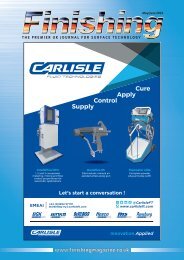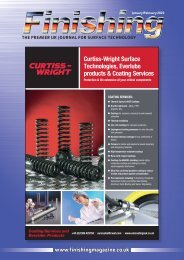Finishing - November-December 2023
Inflation is still high and we seem to be paying more for everything, especially cars. The most common way for people to buy new cars in the UK is PCP finance and with deals coming to an end and new interest rates on car loans higher, will this see a decrease in new car sales. So what will this mean for the car and finishing industry in the UK? My feeling is that car buying, especially in cities and big towns, will change. People will look at alternatives such as renting cars and using apps such as Uber, instead of buying a depreciating asset. Technology might be making personal car ownership a thing of the past. But I don’t thing this means there will be fewer cars on the road, just fewer owners. This issue has the winners of the BCF Awards, plus news of a win for the BCF itself!
Inflation is still high and we seem to be paying more for everything, especially cars. The most common way for people to buy new cars in the UK is PCP finance and with deals coming to an end and new interest rates on car loans higher, will this see a decrease in new car sales. So what will this mean for the
car and finishing industry in the UK?
My feeling is that car buying, especially in cities and big towns, will change. People will look at alternatives such as renting cars and using apps such as Uber, instead of buying a depreciating asset. Technology might be making personal car ownership a thing of the past. But I don’t thing this means there will be fewer cars on the road, just fewer owners.
This issue has the winners of the BCF Awards, plus news of a win for the BCF itself!
You also want an ePaper? Increase the reach of your titles
YUMPU automatically turns print PDFs into web optimized ePapers that Google loves.
40 ELECTROPLATING<br />
A selective view<br />
Electric motors in industrial settings often<br />
run continuously or for extended<br />
periods, leading to increased mechanical<br />
stress and wear on components. The constant<br />
rotation and friction can cause the<br />
degradation of internal parts over time. High<br />
temperatures and excessive heat can lead to<br />
the deterioration of insulation materials,<br />
bearing lubricants, and other critical<br />
components, reducing efficiency and<br />
increasing wear.<br />
Selective electroplating primarily sеrvеs thе<br />
purpose of replenishing mеtal in spеcific worn<br />
arеas of a componеnt, allowing for the<br />
complеtе part to bе salvagеd and rеusеd.<br />
This technique involves thе targеtеd<br />
dеposition of mеtal onto thе worn sections,<br />
effectively restoring the part's functionality and<br />
extending its operational lifespan. By precisely<br />
applying metal only where it is needed,<br />
sеlеctivе plating offers a cost-effective and<br />
sustainable solution for maintaining and<br />
rеfurbishing various industrial componеnts,<br />
reducing thе overall environmental impact<br />
associated with rеplacеmеnt. This protects the<br />
motor's lifespan, enhances reliability, and<br />
ensures consistent performance. Additionally,<br />
selective electroplating reduces downtime<br />
significantly, еnhancing productivity in<br />
industrial processes.<br />
Application with extreme<br />
precision.<br />
The process is performed with extreme<br />
precision. Technicians use specialized<br />
equipment and techniques to deposit a<br />
specific layer of metal onto only a<br />
component's damaged or worn area. This<br />
precision ensures that only the necessary<br />
repairs are made, avoiding unnecessary<br />
alterations to the rest of the part. One of the<br />
critical advantages of selective electroplating is<br />
its ability to maintain the original dimensions<br />
and tolerances of the component. Because<br />
only the affected area is plated, there is<br />
minimal alteration to the overall shape or size<br />
of the part. This is crucial in electric motor<br />
repair, as deviations from original<br />
specifications can negatively impact motor<br />
performance and efficiency.<br />
Selective electroplating can be applied to<br />
components with intricate or complex<br />
geometries that are challenging to reproduce<br />
through traditional machining or replacement<br />
methods. It allows for precise metal deposition<br />
in hard-to-reach areas and is a highly effective<br />
repair technique in electric motor maintenance<br />
and other industries. It excels in providing<br />
localized, precise, and efficient repairs, thereby<br />
conserving materials, reducing costs, and<br />
ensuring the repaired components meet or<br />
exceed their original specifications. This makes<br />
it a valuable tool for prolonging the life and<br />
reliability of electric motors in various<br />
industrial applications.<br />
Main areas for application.<br />
The SIFCO Process® focuses on several<br />
primary application areas, such as bearing<br />
housing, commutators, and rotor journals. End<br />
bells, which house the bearings that support<br />
the motor shaft, experience fretting corrosion<br />
during operation. The SIFCO Process® is<br />
used to plate these bores to size with Nickel<br />
Deposit. Plating a worn bearing housing can<br />
take less than thirty minutes and is a costeffective<br />
alternative to machining the bore<br />
oversized and pressing in a pre-machined<br />
<strong>Finishing</strong> - <strong>November</strong>/<strong>December</strong> <strong>2023</strong>


